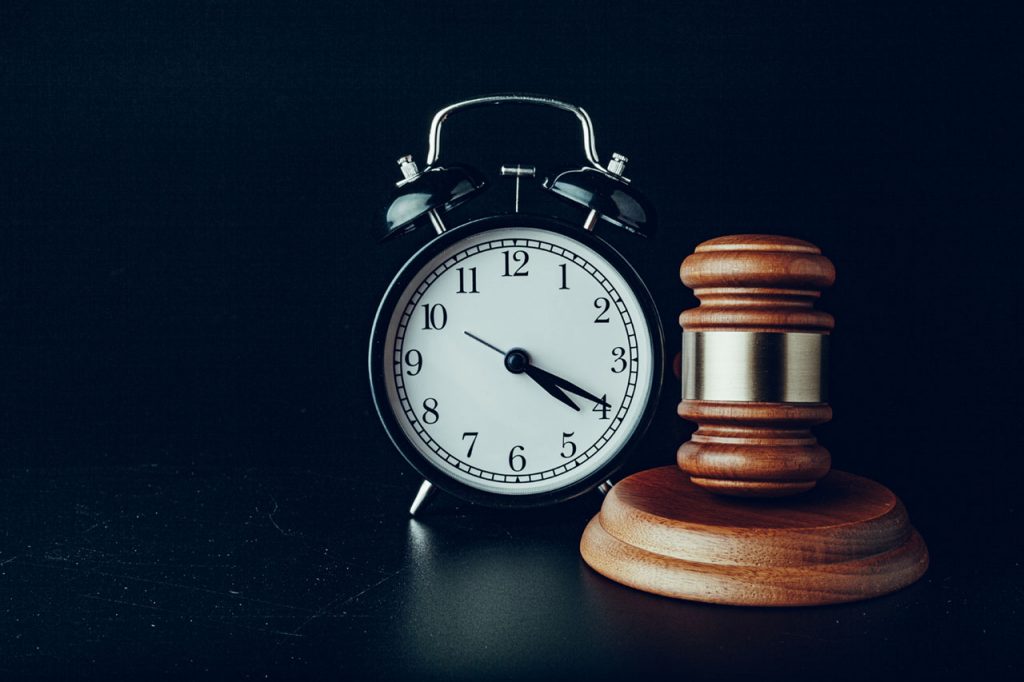By Jeff Wiese, Deputy Director • Office of Court Services, Legal Support Division -AND- Kathryn Dolan, Chief Public Information Officer • Office of Communication, Education & Outreach

Weighted caseload study
A comprehensive study shows the number of judges in the state basically meets the level of need compared to the state’s caseload. The extensive analysis is known as the Weighted Caseload Study. It’s conducted to provide an evaluation of judicial workload and resource allocation across the state.
There are many takeaways from the information gained—including insight into where there is greater need and cases that take more time than others. The overall study shows that Indiana has around 485 full-time judges across the state and that is about what it takes to manage the more than 1 million new cases filed each year in trial courts.
Indiana has around 485 full-time judges across the state and that is about what it takes to manage the more than 1 million new cases filed each year in trial courts.
Why do a weighted caseload study?
The Weighted Caseload Study serves two primary purposes. First, it aims to objectively assess the number of judicial officers required to effectively manage the trial court’s caseload. Second, the study seeks to determine how judicial resources are allocated across the state, ensuring that resources are distributed in a manner that meets the varying demands of different jurisdictions.
By assigning consistent case weights to different case types, the study standardizes the assessment of judicial workload across various jurisdictions, which may differ in geography, population, and caseload composition. This standardization allows for a more accurate determination of judicial officer needs, ensuring that resources are allocated efficiently and effectively to manage the courts’ work.
Who conducted the study?
The National Center for State Courts was contracted to conduct the time study. Their involvement included designing and implementing the methodology for the study and drafting the final report.
“Committee members worked extremely hard to ensure our colleagues understood the importance of the study…”
—Hon. Vicki Carmichael, Clark Circuit Court
Indiana’s Judicial Administration Committee played a leading role in the study serving as a policy committee. The committee engaged in refining the approach and content of the assessment and resolving critical issues affecting data collection, interpretation, and analysis. It monitored the development of the caseload assessment methodology and reviewed findings at each critical phase of the study, including its completion. This involvement ensured that the study was comprehensive and aligned with the needs of Indiana’s trial courts.
Committee co-chair, Clark County Judge Vicki Carmichael, explained, “Committee members worked extremely hard to ensure our colleagues understood the importance of the study and why we needed to ensure we received valid results reflecting the challenging work of Indiana’s trial court judges.”

Indiana’s Weighted Caseload Measures
How the study was conducted
The study utilized an Event-Based Methodology, measuring the time judicial officers spend on various case types and non-case-related administrative time over a four-week period (February 5 to March 1, 2024). The methodology does not track individual cases from start to finish; instead, it aggregates time spent on different segments of the case life cycle, such as pre-judgment, trial, and post-judgment activities.
This approach provides a reliable estimate of the total time needed to process a case, based on observations from thousands of individual case events. The data collected during the study period is considered representative of the court’s caseload throughout the year, offering a direct measure of judicial time devoted to case processing. The study involved participation from all but one of Indiana’s 92 counties. This high participation rate ensures confidence in the accuracy and validity of the resulting case weights.
In addition to the four-week time study, the NCSC:
- Conducted an adequacy of time survey, with 359 judicial officers participating
- Organized focus group discussions with trial court judges to gain insight into their thoughts on time available for case and non-case-related activities
- Conducted in-court observations in Clark, Hendricks, Marion, and White counties plus the Lawrence Township (Marion County) Small Claims Court
The calculations
Judicial year value
This is the total number of minutes each full-time judicial officer has available for case-related and non-case-related activities. The judicial year value is calculated by starting with 365 days and then applying standard deductions including weekends (104 days), state holidays (13 days), paid vacation (21 days), paid sick and personal days (4 days), and required annual judicial training days (10 days). While judges often work nights, weekends, and holidays to keep up on backlogs and respond to emergency requests, for purposes of a uniform statewide study, the standard deductions listed above establish a baseline metric of 213 days or 102,240 minutes per year. This figure represents the judicial year value.
Time needed for non-case-related activities
Non-case-related time is the average amount of time judicial officers reported spending on activities not related to case processing in the time study. This includes time spent on administrative duties, speaking engagements, committee meetings, general legal research, work-related travel, testifying at legislative committee hearings, and other similar activities. In the current study, the Judicial Administration Committee determined judicial officers need an average of 90 minutes per day for non-case-related activities, which is consistent with national averages per the National Center for State Courts. This is a decrease from the 115 minutes reported in the 2016 study.
Time available for case-related activities
Deducting the 19,170 minutes (90 minutes times 213 days) needed for non-case-related activities each year from the Judicial Year Value (102,240 minutes) gives each judicial officer 83,070 minutes each year for case-related activities.
Case weights (weighted caseload minutes)
A case weight is determined by calculating the average amount of time judicial officers spend processing cases within identified case type categories. During the time study, each judicial officer input their time spent on events during each case’s life cycle, such as pre-judgment activities, trial activities, and post-judgment activities by case type. The data collected over the study period was annualized to reflect a full working calendar year. The total time spent on each case type was divided by the average number of cases filed for that type over the previous three calendar years, resulting in the average judicial minutes required per case type. This is the case weight.
Judicial have
This is the total number of state-paid judges and magistrates plus county-paid commissioners and referees assigned to a court, a county, a judicial district, or the state. Judicial have is calculated by determining the number of judicial officers authorized by statute for each circuit, superior, and probate court and adding the number of county-paid commissioners and referees reported to the Office of Court Services on the quarterly case status reports. Keep in mind, some positions are part-time. Many part-time positions add up and are reflected as full-time; for example, two part-time positions are counted as one full-time position.
Judicial need
This is calculated by determining the total number of judicial officer minutes required to manage all new case filings (by case type) in a court (or a county, judicial district, or the state as a whole) for a year. This involves several steps:
- Collect new case filings in each case type for the most recent full year.
- The new filings in each case type are multiplied by the corresponding case weight. This represents the average judicial minutes required for each case type.
- The totals for each case type are totaled to get the number of judicial minutes needed for all new filings in that court/county/judicial district/state for the year.
- Divide by time available for case-related activities: This total is divided by the time available for case-related activities (83,070 minutes) in a year. This calculation yields the number of judicial officers needed to manage the new filings. This is the Judicial Need.
Utilization rate
The utilization rate of a court/county/judicial district/state is determined by calculating the ratio of its judicial need to its judicial have. A utilization rate of 1.00 indicates a perfect balance between the need and the available judicial resources. A rate over 1.00 suggests that there are not enough judicial officers to manage the new case filings, indicating a need for judicial resources. A utilization under 1.00 indicates judicial resources are available to handle additional new case filings.
Key Findings
Ultimately, Indiana’s rate is shown as having balance. Indiana currently has 488.61 judicial officers, while the actual need is 480.55. The statewide utilization rate is 0.98, remarkably close to the optimum 1.00. The distribution of judicial resources is uneven across counties, however. Some counties still have need for additional judicial resources while other counties may have capacity to take on additional new filings.
“This study is one component in the larger conversation about the challenges, funding, and wise use of judicial resources both locally and statewide.”
—Hon. Matthew Sarber, Marshall Superior Court

Sharing judicial resources across county lines is permitted by Administrative Rule 1 and is encouraged for counties with utilizations under 1.00 to help surrounding counties with need. Judge Carmichael stressed the importance of judges across the state working together in their counties and judicial districts so all people with matters before Indiana’s trial courts are heard in a timely manner.
A significant insight from the study is the increasing complexity of cases, driven by modern technology and changes in laws, which complicate case processing. Judges report feeling rushed, particularly in family cases, and express concerns about the growing administrative duties.
The study highlights the importance of focusing on judicial time spent on specific cases rather than merely looking at the number of cases divided by the time available. While infractions (like traffic tickets) are the most frequently filed cases, they account for a small percentage of judicial time. In contrast, Level 6 felonies and domestic relations with children are among the most time-consuming cases. The study results reflect the complexity of each case type and the time needed for judges to handle the cases.
Judicial Administration Committee co-chair Marshall County Judge Matthew Sarber appreciates the importance of the study, “Indiana judges face growing challenges and remain committed to dedicating time to each case before them. Litigants are increasingly asking judges to decide complex questions about society, constitutional issues, and ongoing behavioral health concerns. This study is one component in the larger conversation about the challenges, funding, and wise use of judicial resources both locally and statewide.”
Other topics examined in the study
Eviction cases
In the study, the Judicial Administration Committee tried to determine if residential evictions and commercial evictions took different amounts of time. However, it found that breaking out evictions into residential and commercial categories was more challenging than anticipated. The committee was able to conduct a sample analysis of eviction cases which revealed no significant differences in processing time that would justify creating a new case type for commercial evictions.
Protection order cases
The committee also examined whether the time associated with harassment protection orders, compared to all other protection orders, was different enough to justify a separate case type. The data did not show enough difference in processing time between the two types of protection orders to warrant a recommendation for a new case type. This suggests that the existing protection order case type is sufficient to cover the time requirements for both types of protection orders.
Grandparent visitation cases
Office of Court Services guidance suggests grandparent visitation cases should be filed using the civil miscellaneous case type. However, in reality many petitions for grandparent visitation are filed in existing dissolution or paternity cases. The Judicial Administration Committee included grandparent visitation as a category judicial officers could choose when reporting time during the time study, however, not enough data was collected to accurately determine a case weight for grandparent visitation. The committee received approval from the Supreme Court for a grandparent visitation case type effective January 1, 2025.
Commercial courts
The Commercial Courts Committee requested the Judicial Administration Committee study the average amount of judicial time needed for a commercial court case and the impact of having state-paid law clerks.
Time needed to process commercial court cases
Currently, commercial court cases are filed in various case types ranging from PL to CC that do not adequately account for the time necessary for a typical commercial court case. The Supreme Court approved a commercial court case type effective January 1, 2025, that will account for the complexity of these cases. The Judicial Administration Committee determined commercial court cases should receive 325 minutes more than a PL case. To receive this credit, each commercial court will need to report new commercial court case filings on its quarterly case status report, like the reporting required by a problem-solving court.
Importance of law clerks in commercial courts
Five state-paid attorney law clerks are shared between the commercial court judges which significantly contributes to the management of complex cases. The clerks help with legal research, drafting opinions, and managing case documentation. The study found that without the clerks, the judicial system would require more resources to effectively manage the cases.
Marion County small claims courts
Marion County small claims courts participated in the study for the first time. However, their data was not included in the final case weights for small claims and eviction cases because the Marion County small claims court judicial officers are paid by the township, not the state. The Judicial Administration Committee will provide the time study data to the Marion County small claims courts.